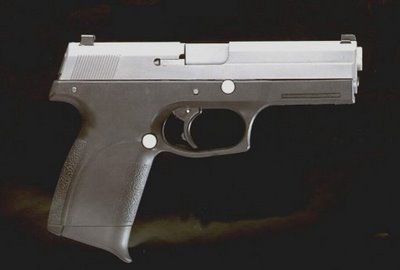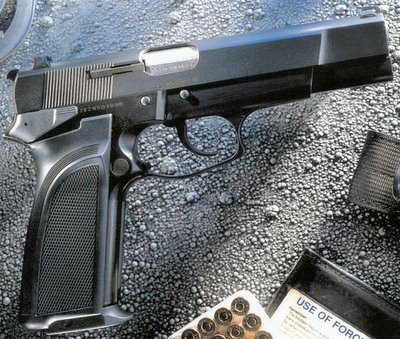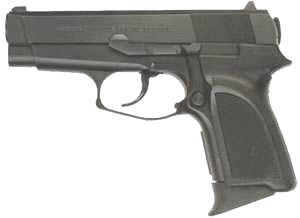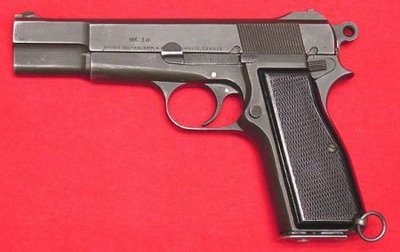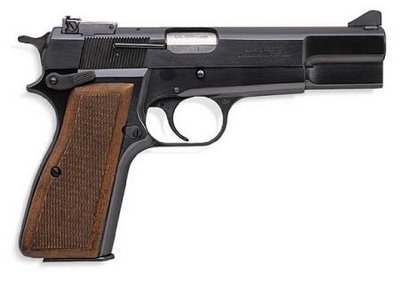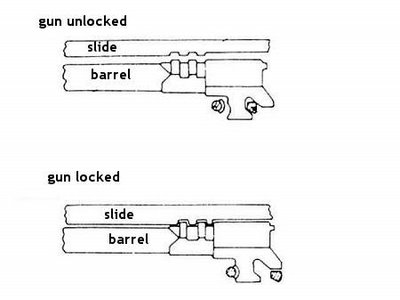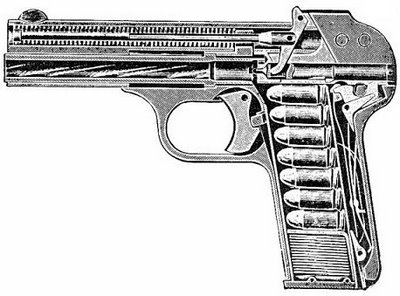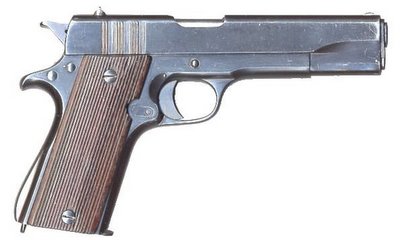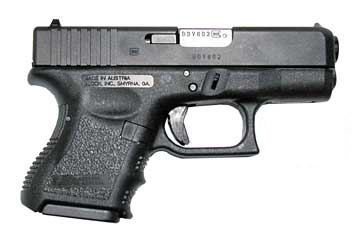latest guns pistols and other weapons
welcome to my blog! here you can find oldest and latest kinds of weapons as i add them all to make you all satisfied ... peace! enjoy it
Saturday, October 07, 2006
Taurus PT 92 C (compact)

Taurus PT 100
Type: Double Action (DA with Decocker in models AF-D)
Chamber: PT 92/99 - 9x19mm Luger/Parabellum; PT 100/101 - .40S&W
Weight unloaded: ca. 960 g empty (ca. 900 g empty model 92C)
Length: 216 mm (203 mm mod 92C)
Barrel length: 127 mm (108 mm mod 92C)
Capacity: 15 rounds (10 rounds for US civilian market)
The Taurus pistols are manufactured by Brazilian company Forjas Taurus SA. The original PT92 pistol was exact copy of the original Beretta 92 pistol, and PT92 still carries some of the original Beretta features, such as frame mounted safety, but, since its introduction, Taurus PT92 had been significantly improved, and currently represents affordable pistol of high quality.
Technically, PT92 is a recoil operated, locked brech pistol, that uses shor recoiling barrel with underbarrel locking piece that tilts down to unlock slide from the barrel (Walther P38 / Beretta 92 type locking). The trigger is of Double Action type, with ambidextrous frame mounted manual safety. On models marked AF-D safety also acts as a decocker when pressed all the way down (below the "fire" position). When safety is in "safe" position, it locks the slide and disconnects the trigger and sear. Current PT92 and its derivatives also featured automatic firing pin safety. The frame and slide could be made either from carbon steel with blue finish or from stainless steel wit polished finish. Sights are of fixed type.
Apart from PT92 itself, Taurus makes some derivatives of its basic model:
PT 92 C - compact model, with shortened grip, slide and barrel. Accepts standard PT92 magazines.
PT 99 - similar for PT 92 except that the rear sights are micrometer click ajustable.
PT 100 - similar to PT 92 but chambered for .40SW cartridge
PT 101 - similar to PT 99 (ajustable sights) but chambered for .40SW cartridge
FNP-9 / Browning PRO-9 pistol (Belgium / USA)
istol

same pistol in civilian guise is marketed as the Browning PRO-9
Type: Double ActionCalibers: 9x19mm Luger/Parabellum and .40S&WWeight: ~710 g empty; 890 g loaded with 16 rounds Length: 200 mmBarrel length: 100 mmCapacity: 16 rounds (9mm) or 10 rounds (.40)
The FNP-9 is the most recent development of the famous Belgian company FN Herstal. First announced in 2003, the basic design is available in two versions. The Law Enforcement / Military version is marketed as FNP-9, and has a matte black finish; the Civilian version is marketed as the Browning PRO-9, and has a bead-blasted stainless steel finish on the slide. Frames on all models are black polymer. These pistols apparently made at two FN facilities - for European market guns are produced at FN home factory in Herstal, Belgium; for US market guns are made in FN plant in Columbia, South Carolina, USA, by the FN Manufacturing Inc, subsidiary of the FN Herstal.
By modern standards, FNP-9 / PRO-9 is a fairy conventional gun, suitable for police / security duties, as well as for self-defense. Actually, the FNP-9 is a vise compilation of previously known design features, including the now-common polymer frame, SIG-Sauer-style locking system, interchangeable grip backstraps, pioneered by Walther. FNP-9 is quite comfortable and apparently very reliable, and, probably, will be more successful on the market, than the previous FN polymer-framed pistol, the Forty-Nine.
The FNP-9 is a short recoil operated, locked breech pistol. The barrel is operated using a Browning cam system, and is locked to slide by single lug via large ejection port. Frame is made from high impact-resistant polymer. Double Action trigger system with exposed hammer has internal firing pin safety, with decocking levers located at the both sides of the frame. Firing pin safety is standard, and the magazine safety is optional. The trigger / hammer module is formed as a single unit, easily detachable from the frame for inspection, maintenance or replacement. Optional hammer units can be found in DAO variety or in standard DA version but with manual safety / decock levers instead of the basic decock-only levers. Other easily replaceable units include the barrel cradle / slide rail module and the grip backstraps. Grip backstraps are available in two variations, with straight or curved shape. Front part of the frame under the barrel is formed as an integral accessory rail for flashlight or laser sight. Standard sights are provided with white inserts and are dovetailed into the slide.
Fabrique Nationale (FN) Fourty-Nine (Belgium)
Type: Double Action Only (Repeatable Secure Striker)
Chambering: .40 S&W
Length: 197mm
Weight: 740g
Barrel length : 108mm
Magazine: 10 rds
FN Forty-Nine is a modern service handgun, intended primary for police/security use. It is recoil-operated, locked breech firearm that uses improved Browning linkless locking principle. The gun is striker fired, and unlike many other striker-fired guns, like Glocks, Forty-Nine is a true DAO gun, with availability of re-striking the misfired cartridge simply with another trigger pull. The striker is completely at rest until the trigger is pulled, so gun is safe. It has no external safety switches or decockers for simplicity and readiness to use. The main drawback of this system is long and heawy trigger pull - almost 10 lbs (ca. 4.5kg). The frame of the gun is made from black polymer, the slide is made from stainless steel. Gun also has acessory rails on the frame under the barrel, for quick and easy mounting of the laser designators and flashlights.
Fabrique Nationale (FN) Five-seveN (Belgium)
Type: Double Action Only or Single Action (in Tactical model)
Chambering: 5.7x28mm SS190
Length: 208 mm
Barrel length : 122.5 mm
Weight: ca. 620 g with empty magazine; ca. 760 g
loadedMagazine: 20 rounds
The Five-seveN pistol was designed by FN company (Belgium) as a complimentary sidearm for the P90 submachine-gun. The P90 and Five-seveN share the same ammunition, the 5.7x28mm SS190 cartridge. The SS190 ammunition looks like scaled down 5.56mm NATO round and boosts the 2.02 gramm (31 grains) pointed steel and alluminium core bullet to the muzzle velocity of 650 meters per second (ca. 2130 fps) from the pistol barrel. The key idea behind that ammunition and weapons is to provide good penetration against personnel, protected by modern body armour, while keeping weapons' weight, dimensions and recoil at the reasonable levels.
The Five-seveN is a delayed blowback operated, semi-automatic firearm. It featured polymer frame with underbarrel acessory rail. The gun is available in two versions: Five-seveN standard, intended mostly for military users, and Five-seveN Tactical, intended mostly for Law Enforcement users who carry handguns as a primary weapons. The only difference between Standart and Tactical models is in the trigger type: the Five-seveN standard features Double Action Only trigger with long trigger pull and no external safeties; The Five-seveN Tactical featured Single Action trigger with short and light trigger pull and ambidextrous safety switch, located on the frame above the trigger. Both variants are striker fired, with internal firing pin safety. The sights are fixed, with optional night sights (with luminous dots inserts) available.
The Five-seveN is advertised as being capable to penetrate standart PAGST vest at 300 meters and standart CRISAT (kevlar + titanium) vest at 100 meters.
The Five-seveN is available from FN for government or law enforcement sales only.
Browning BDM (USA / Belgium)

Browning BDM, another view (total blue finished gun)
Type: Double Action or Double Action Only manually selective
Chamber: 9x19mm Luger / Parabellum
Weight unloaded: 870 g
Length:
Barrel length: 120 mm
Capacity: 15 rounds
The Browning BDM pistol is an interesting development, that first appeared in 1991 and was in production until late 1990s (maybe 1998 or 1999, not sure). While most of pistols that carry the John Browning name usually were originated from Belgium (models 1910, 1922, "Baby", "High Power", etc), some pistols were made in other countries. Not to mention Colt pistols, designed by Browning, the Browning Arms company of USA imported german-made SIG-Sauer P220 pistols under the name of Browning DA in 1970s. Then came the Browning Buckmark pistol, made in USA. And, finally - the Browning BDM. This gun was designed and produced in the USA by FN manufacturing Inc., an US subsidiary of the Belgian company FN Herstal, who also owned the Browning trade mark, and Browning name is linked to the Belgium (as well as to the USA) for ever, so i voluntary assign the BDM to both countries, with the USA first.
BDM stands for the Browning Double Mode (or Dual Mode), and it's mean that the pistol can be had in either traditional Double Action mode or in Double Action Only Mode ... in the same gun, and the change of mode can take a split a second, not more. It is done via the small slotted switch in the left side of the slide. The switch has two positions, marked "P" and "R". P stands for Pistol, or DA mode, R stands for revolver, or DAO mode. The switch can be turned from one position to another by any sharp-tipped tool such a knife, skrewdriver or even a coin. BDM is equipped with ambidextrous, frame-mounted safety / decocker levers. To engage safety (and decock the hammer in DA mode) one must pull the lever down, and the lever will stay in this position. To disengage safety the lever must be pulled up, so a red dot will show on the frame.
While being quite similar to the Browning BDA pistol, the BDM differs from it in the number of ways. First, being a recoil operated, locked breech pistol with Browning High-Power type (surprise, surprise) tipping barrel, the BDM has SIG-Sauer-like locking system, when barrel engages with single large lug into the ejection port on the slide. Another change from traditional "Browning" style is a disassembly lever on the left side of the frame, that must be turned down for removal of the slide and barrel, instead of the traditional HiPower method where you remove the slide catch lever. The slide stop is also of different pattern, without the usual Browning-ish long lever, and with only small lip protruding from inside the frame. Sights and grip panels are similar to Browning BDA or Browning High Power Mark III.
The BDM is one of the thinnest full-size, high capacity combat pistols. It is also reported as reliable and comfortable to carry and shoot, but unusual safety operations require some shooters' adaptation.
Browning DA / FN HP-DA / BDA9 / BDAO (Belgium)

FN HP-DAO / Browning BDAO - current production DAO model

FN HP-DA disassembled to main components
Type: Double Action or Double Action Only
Chamber: 9x19mm Luger / Parabellum
Weight unloaded: 905 g (current model); 850 g (early model); 710 g (compact model)
Length: 200 mm standard model; 173 mm compact model
Barrel length: 118 mm standard model; 96 mm compact model Magazine
capacity: 14 rounds standard; also 7 rounds for compact models
Due to increased popularity of the military-style double action pistols, engineers of the Belgian FN Herstal company developed a double action variation of their famous FN / Browning "High Power" (GP35) pistol. First appeared in 1983, the new pistol was called as Browning Double Action (for American market) or FN HP-DA (for European market). Having similar construction and general outlines similar to old High Power pistol, the new gun differed from it in some ways. First of all, it has Double Action trigger with ambidextrous, frame mounted decocker lever instead of manual safety. Hammer spur was decreased in size, triggerguard reshaped for better two-hands hold. Slide also had slightly different contours of the front part. Magazine capacity was increased by 1 round and now it hold 14 rounds plus one in the chamber. Along with Standard version FN developed a Compact (HP-DAC) and Medium (HP-DAM) versions of the basic design. Compact pistol had shortened barrel, slide and grip, which held shortened, dual-stack magazine with 7 rounds. Standard, 14 rounds double-stack magazines also fit to Compact model. Medium model was a hybrid of the Standard frame and Compact barrel and slide. Due to some reasons, neither model sold well and FN discontinued this line circa 1987.
Later, in 1990, FN decided to bring a Double Action High Powers back to life. Using new manufacturing processes and a redesigned DA trigger, FN engineers produced a new variations, called Browning BDA9 and BDAO (for American market) or FN HP-DA and HP-DAO (for European market). BDA9/HP-DA differed from earlier HP-DA very little (most visible change is in decocking lever - newest guns has longer, triangle-shaped levers for better control). BDAO / HP-DAO is a further step down to modern trends and is a Double Action Only gun, withouth any manual safeties or decocker levers.
Unlike the original HP-DAs, newest models found its niche on European military and police market, and also sold in USA.
Technically, HP-DA / BDA9 is a recoil operated, locked breech semiautomatic pistol. It uses Browning cam to interlock barrel and slide. Trigger is of double action type with ambidextrous decoker and internal fireing pin safety or of double action only type with firing pin safety only. Additional safety prevents pistol from firing if slide does not closed completely. Basic design featured fixed sighst that are dovetailed into the slide. Magazine is double-stack and holds 14 rounds. Magazine release button is located behind the triggerguard and can be installed on either side of the gun by the user.
In general, the HP-DA / BDA9 pistol represents slightly conservative, but still sound approach to combat pistol, offering good firepower, reliability and reasonable safety level.
Browning BDA 380 (Belgium)


Type: Double Action
Chamber: 9x17mm (.380ACP) or 7.65x17mm (.32ACP)
Weight unloaded: 640 g
Length: 173 mm
Barrel length:
Capacity: 12 (9mm) or 13 (7.65mm) rounds
The Browning BDA 380 pistol was introduced in 1980 or so as a compact and lightweight pistol for police and civilian use. The gun was manufactured in Italy under contract from FN Herstal (Belgium) and marketed as FN model 140DA (in Europe) or Browning BDA 380 (in USA). Some sources said that BDA 380 is a copy of Beretta 84, but close inspection shows some differences (i.e. Beretta 84 has frame mounted safety while BDA 380 has slide mounted safety). The manufacture of the BDA 380 was ceased circa 1997. It was adopted by Belgian police.
The BDA 380 is a blowback operated, double action semi automatic pistol. It has aluminium alloy frame and steel slide. Ambidextrous slide mounted safety switch disconnects the trigger from the hammer when engaged. The pistol featured low profile fixed sightst and was available in either polished steel or blued finish, with wooden grip panels.
The gun deserved good reputation as reliable and comfortable to fire.
Fabrique Nationale (FN) Browning "High Power" (HP) (Belgium)
 Browning High Power, also made by Inglis, but with tangent ajustable rear sights and attached holster/shoulder stock
Browning High Power, also made by Inglis, but with tangent ajustable rear sights and attached holster/shoulder stockType: Single Action
Chambering: 9mm Parabellum (also 7.65mm Parabellum and .40S&W in commercial/civilian models)
Length overall: 200 mm
Barrel length: 118 mmWeight: 885 g
Magazine: 13 rounds (10 rounds in .40SW)
Initially, the "High Power" pistol was designed by John M. Browning in 1925 and was patented in the USA in 1927, soon after the death of the Browning. The design was aquired by Belgian state-owned company FN Herstal, and improved by FN designer Dieudonne Saive. The resulting pistol was shelved until 1935, when Belgian army was ready to adopt new sidearm. The HP was offered for trials and won, and was adopted as a Model 1935 pistol. Soon after that it was also adopted by Belgian police and by many foreign countries, including Britich Commonwealth ones (UK, Canada, Australia etc.). The High Power is the only sidearm that served for both sides in WW2 - Germany used many HPs manufactured in occupied Belgium, while Allies used HPs manufactured mostly in Canada by company Inglis. The HP continues its service well into XXI century with belgian Army and Police, British army and many other military and Law Enforcement agencies, being second longest living service pistols after the another famous Brownings' design, the Colt 1911.
Thechnically, the High Power pistol, also known as Browning HP 35, GP 35 or Model 1935, is a recoil operated, locked breech pistol. It uses linkless barrel to slide locking (see picture above), invented by Browning. The trigger is single action, with external hammer. Original HPs featured frame mounted safety at the left side of the frame, that locks both sear and slide. Modern versions, since Mark II, also featured ambidextrous safety levers, that are also more comfortable to operate. Original HPs were available with two sight wersions - with standart fixed sights, and with rear tangent sights ajustable for distance from 50 to 500 meters. Some pre- and WW2-time guns also featured backstraps with cuts to accomodate removable shoulder stocks/holsters. Grip panels were made from wood, and pistols were availabli with or without lanyard rings. The HP was the first military pistol to have high capacity, staggered column magazine for 13 rounds plus one loaded in the chamber.
Newer Military/LE versions, such as Mk.II and recent Mk.III (also marketed under the name of HP-SA with added firing pin safety), featured more modern fixed combat sights and polymer grip panels. Commercial models may feature different sight options and finiches. Lates addition to the High Power family is a variation chambered in .40S&W cartridge. It has redesigned and strenghtened slide to accomodate more powerful cartridge, and magazine capacity of 10 rounds.
In 1980's or so FN also developed version of the HP with double action trigger, that was named HP-DA. It is still marketed by FN, but didn't catch the market as well as its predescessor did.
Copies and clones of the HP are still manufactured around the worls, such as Hungarian FEG 9, Bulgarian Arcus etc.
Browning 1910, 1922 and 380 (Belgium)
 Browning model 380 "Renaissance"-grade factory engraved(post-1971 manufactured model 1922 derivative, made for USA)
Browning model 380 "Renaissance"-grade factory engraved(post-1971 manufactured model 1922 derivative, made for USA)
Browning model 1922, cut-out view
Type: Single Action
Chamber: 7.65x17mm Browning (.32ACP) and 9x17mm Browning (.380ACP)
Weight unloaded: model 1910 - ca. 590 g; model 1922 - ca. 700 g
Length: model 1910 - 153 mm; model 1922 - 178 mm
Barrel length: model 1910 - 88 mm; model 1922 - 113 mm
Capacity: model 1910 - 7 (7.65mm) or 6 (9mm) rounds; model 1922 - 9 (7.65mm) or 8 (9mm) rounds
Model 1910 pistol had been developed by John M. Browning for Belgian company Fabrique Nationale (FN), Herstal. Model 1910 had been developed around two cartridges, also designed by Browning - the 7.65mm Browning, also known as .32ACP, which had been developed around 1900 for FN / Browning model 1900 pistol, and the 9mm Browning Short (9x17mm), also known as .380ACP, which, in turn, had been developed about 1908 for Colt / Browning model 1908 pistol.
In 1922, Browning modified the original pistol to suit requirements of the Jugoslavian military - he lenghtened barrel, enlarged the grip and magazine capacity by two rounds. The slide was lenghtened by adding removable frontal portion to the model 1910 slide.
Both models 1910 and 1922 were manufactured in large quantities until 1983 or so, when these guns were replaced by FN model 140DA / Browning BDA380 pistols. In the USA both model 1910 and model 1922 were imported under the name of "Browning 380 pistol", chambered in .380ACP. After the 1971, these guns have had ajustable target-type sights and slightly enlarged grips to suit new US gun laws. Between two World Wars these pistols became very popular across Europe as a police, military and self-defence guns. It is well-known also that the First World War was started by the Browning m1910 pistos, which had been used in 1914 to assasinate the Archduke Ferdinand.
Technically, both m 1910 and m 1922 (also known as model 1910/22), are blowback operated semi-automatic pistols. The recoil spring is located around the barrel, the trigger is of single action type and the gun is striker-fired. Both models featured three safeties - magazine safety (which blocks the firing when magazine is removed), automatic grip safety and manual, frame mounted safety.
FN / Browning M.1903 (Browning No.2) pistol (Belgium)
Type: Single Action, Semi-automatic pistol
Chamber: 9x20mm SR Browning Long, 7.65x17mm SR Browning (.32ACP)
Weight unloaded: 930 g
Length: 205 mm
Barrel length: 127 mm
Capacity: 7 rounds (9mm) or 8 rounds (7.65mm)
The M1903 was the second production blowback-operated pistol, designed by famous American arms designer John Browning by 1902 and patented in 1903. Also known as the Browning No.2 pistol, this design was a serious improvement over the older No.1 (FN - Browning M1900
pistol. At the same time Browning developed the recoil-operated M1900 for Colt. This design also was manufactured by the Colt Firearms Co of USA as the Colt M1903 pocket pistol, chambered in .32ACP (7.65mm). Both FN and Colt produced this design until 1930s. In Europe, The FN M1903 became a favorite police pistol, and also was adopted by several armies, included Belgian, Dutch, Turkish and Swedish ones, as well as by Imperial Russian police. It was manufactured in Sweden under license at Husqvarna Vapenfabriks from 1917 and until 1942, as the 9mm M/1907. In the USA, the Colt m1903 became popular as a civilian self-defense pistol, and also was issued to the senior army officers and generals as a standard self-defense weapon. FN built slightly less than 60 000 M1903 pistols, plus Husqvarna built another 94 000 pistols.
This pistol can be called as a forerunner of most semi-automatic pistols in the world, in one or another respect. Significantly underpowered by modern standards, it was, however, reliable, accurate and comfortable to carry and fire. It also offered much faster reloading procedure than any of contemporary military revolvers.
Technical description.
The Browning M1903 (does not matter, if it was made by FN in Belgium or by Colt in USA), is a blowback operated, semi-automatic pistol. The recoil spring was located under the barrel, as in most modern pistols. The single action trigger unit has a concealed hammer (Colt also produced similar models with open hammers). The non-pivoting trigger is somewhat similar to the latter Colt/Browning M1911 trigger. Manual safety switch is located at the left side of the frame, above the grip panel. When engaged, it locks the sear and the slide. It also locks the slide in the open position for disassembly. Additional automatic grip safety locked the sear unless the gun is properly held in the palm. Barrel is locked to the frame by several radial ribs. To disassemble the pistol, one must retract the slide, lock it open with the safety, then rotate barrel out of engagement with the frame, and then remove barrel and slide. Automatic slide stop (hold open) device was also incorporated, with the visible lever located at the right side of the frame, above the triggerguard. Single stack magazine is inserted in to the butt and locked by the lever at the heel of the grip. Military issue pistols also had lanyard ring on the left side of the grip.
FN / Browning M.1900 (Browning No.1) pistol (Belgium)
Type: Single Action, semi-automatic pistol
Chamber: 7.62x17mm SR (.32ACP)
Weight unloaded: 625 g
Length: 172 mm
Barrel length: 102 mm
Capacity: 7 rounds
The FN / Browning model 1900 pistol was a first of a long and extremely successful series of the Belgian-made pistols, designed by the American firearms genius John Moses Browning. The first semi-automatic, blowback operated pistol was designed by J. M. Browning circa 1896 and latter improved by the 1897. He offered his design to Belgian company FN Herstal circa 1898, and production began in 1899, as the Modele 1899. in 1900, this pistol, in slightly modified form (with barrel shortened from 122 to 102 mm), was adopted by Belgium as Mle.1900. Relatively simple and well designed, this pistol is also known as the Browning Number 1 pistol (Browning No.1). Widely used across Europe as a civilian and police sidearm, this was chambered for a new smokeless round, 7.62x17mm SR, which is also known in Americas as the .32ACP (.32 Colt Automatic). FN - Browning M1900 was widely copied in many countries, especially in S-E Asia. It was manufactured until the 1911 or so, with more than 700 000 pistols made.
Technical description.
The M1900 is a blowback operated, semi-automatic (self-loading) pistol. The barrel is fixed to the frame. The recoil spring is located within the slide and above the barrel. This spring, via special lever, also acts as a firing pin spring. M1900 is a striker fired, single action weapon. Unlike all latter designs, the ejection port is cut in the frame, and not in the slide. Safety switch is located at the left side, above the grip panel. Magazine is removable, is inserted into the pistol handle and holds 7 rounds. Magazine catch lever is located at the heel of the grip. Sights are fixed.
Bersa Thunder-380 pistol (Argentine)
Type: Double Action
Calibers: 9x17mm Short/Kurz (.380ACP) and 7.65x17SR (.32ACP)
Weight unloaded: 560 gram
Length: 168 mm
Barrel length: 90 mm
Capacity: 7 (9mm) or 9 (7.65mm) rounds standard
Bersa Thunder-380 pistols are manufactured in Argentine by Bersa S.A. company, as a compact self-defense side arms for civilians and police. being inexpensive and of good quality, these pistols offer a good level of protection with decent ergonomics. These pistols must not be confused with larger and more powerful Bersa Thunder 9 and Thunder 40 pistols from the same company.
Bersa Thunder-380 pistols are simple blowback operated, with the return spring located around the barrel. The trigger is of double action type, with exposed hammer. The safety switch is located at the left side of the frame, and, when engaged, automatically decocks the hammer. There is also an internal firing pin safety, which blocks the firing pin unless the trigger is pressed. Magazine release button is located above and behind of the trigger guard, at the left side of the frame, and just below of the slide stop lever. Single stack magazine holds seven 9mm (.380) or nine 7.65mm (.32) rounds. Deluxe versions of the Thunder-380 are equipped with extended magazines, which hold nine rounds of 9mm/.380 ammunition. Front sight is integral to the slide, rear fixed sight is dovetailed to the slide. Latest production pistols also feature an integral key lock, located above the trigger, on the left side of the frame.
Bersa Thunder and Thunder Mini / Ultra-Compact pistols (Argentine)
Bersa pistols are manufactured in Argentine by the Bersa S.A. company. Thunder pistols are available, in several different versions. The Thunder-380 pistols are of simple blowback design, while more powerful Thunder-9, Thunder-40 and Thunder-45 pistols are of locked breech design. Thunder series pistols are relatively compact and handy, yet they offer significant capacity with major pistol calibers, combined with good, fully ambidextrous ergonomics. Bersa pistols also are relatively inexpensive and offer decent reliability, making them good personal defense firearms. The only differences between Thunder and Thunder-mini pistols (which also sold as Thunder Ultra-Compact) are size and magazine capacity. The Ultra-Compact .45 pistols are roughly intermediate in size between standard and mini pistols, and, unlike smaller caliber brothers, they have a single stack magazine. Bersa Thunder 9 pistols are standard issue pistols for the Argentinean Federal Police and the Buenos Aires Province Police.
Bersa Thunder-9, Thunder-40 and Thunder-45 pistols are locked breech, short recoil operated firearms of Browning type. barrel is locked to slide by single large lug, which engages the ejection port in the slide. The unlocking is caused by the cam-shaped underbarrel extension. Trigger is of double action type, with exposed hammer and ambidextrous frame mounted safety, which decocks the hammer when engaged, then locks the slide and sear. The action also features a firing pin safety, which blocks the firing pin until the trigger is pressed. The slide release lever also is ambidextrous, and the magazine release button can be easily mounted on the either side of the grip. magazines of the 9mm and .40SW versions are of double stack type, .45 caliber magazines are single stack. Sights are fixed, with front sight integral to the slide and rear dovetailed to the frame. Latest production pistols also feature an integral key lock, located above the trigger on the left side of the frame, as well as accessory laser / light rail on the frame below the barrel.
Friday, October 06, 2006
Ballester-Molina / Ballester-Rigaud pistol (Argentine)
Type: Single Action
Calibers: .45ACP
Weight unloaded: 1075 gram
Length: 216 mm
Barrel length: 127 mm (5")
Capacity: 7 rounds
The Ballester-Molina pistol, originally known as Ballester-Rigaud (so marked during first years of manufacture, circa 1938 to 1940), were made in Argentine by Hispano Argentina de Automotives SA (HAFDASA) company. Manufacture started in 1938 in attempt to provide Argentinean police and military with less expensive alternative to the Colt modelo 1927 pistol, domestically made licensed copy of the American Colt M1911A1 pistol. Production of the Ballester-Molina ceased in the early 1950s. While Ballester-Molina pistol is externally very similar to Colt, it has significant differences, especially in the safety and trigger unit arrangements. Actually, the only parts exchangeable between Ballester-Molina and M1911A1 are the barrel with link and the magazine. The trigger and safety arrangements were more or less copied from the Spanish Star pistols, with the pivoting trigger, single trigger to sear link, and no grip safety. Ballester-Molina pistols were used by Argentinean military and police, as well as supplied to the Britain during Second World war. Britain issued these pistols to their Special Operations Executives agents, which usually operated behind enemy lines.
The Ballester-Molina pistol is a short recoil operated, locked breech pistol. the locking system is similar to that of Colt M1911A1, with the swinging link used to unlock the barrel from the slide. The single action trigger is pivoted on the axis, the frame-mounted manual safety locks the slide and the hammer.
Steyr GB (Austria)
Type: Double Action
Chamber: 9x19mm Luger/Parabellum
Weight: 845 g empty; 1285 g loaed
Length: 216 mm
Barrel length: 136 mm
Capacity: 18 rounds
The development of the GB pistol was started by Steyr-Daimler-Puch AG (now Steyr-Mannliher AG), Austria, in the early 1970s, when the Austrian army announced its plans to replace aging P38s and High Powers with the new pistol. Original design, labelled as PI-18, was developed in 1974, and final version, called GB, entered production in 1981. The production of the GB was ceased circa 1988, after some 15.000 to 20.000 pistols had been produced.
The GB is a blowback-operated, gas-retarded blowback semi auto pistol. It uses some of the hot powder gases, feed from the barrel into the front part of the slide, to slow down the retraction of the slide before the bullet leave the barrel. This scheme was developed by German engineer Barnitzke at the end of the WW2. The gas brake is formed by the barrel, its bushing and the slide.The trigger of the GB is of double action design, with the slide mounted decocker lever. GB also featured firing pin block that unlocks the firing pin only when the trigger is completely depressed.
The frame and the slide is made from carbon steel with special high-strenght finish. Barrel has polygonal rifling and is chrome lined, and solidly attached to the frame.The sights are fixed and featured white-dot inserts (one in the front sight blade and two - around the rear sights notch). Some early GBs were manufactured with steel grip panels, with all the rest manufactured with plastic checkered grips.
Thanks to its gas-retarded blowback design and solid weight, that resulted in low felt recoil, and to the barrel with polygonal rifling, that toesn't move when firing, the Steyr GB displayed wery good accuracy. The reliability is also adequate, at least. While the GB failed at the Austrian and USA Army pistol trials (won respectively by Glock 17 and Beretta 92FS-B), it was used by some Law Enforcement and Special Operations forces, and also was sold to civilians in Europe and USA.
qGlock family of handguns (Austria)
 Glock 17 - basic model (9mm); Modern version with finger grooves on the grip and underbarrel acessory rail.
Glock 17 - basic model (9mm); Modern version with finger grooves on the grip and underbarrel acessory rail.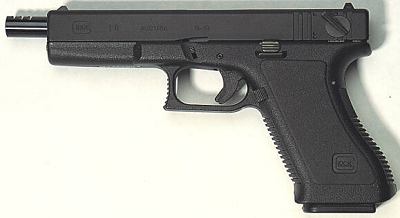
Glock 18 - select-fire model (9mm). Early version with extended barrel and integral compensator.Note fire mode selector switch on the slide

The Glock family of pistols, once started by famous Glock 17 pistol, was developed by Austrian company Glock Gmbh., previously known for quality knives and entrenching tools. The Glock 17 pistol first appeared at the Austrian Army trials, won it and was adopted by Austrai Army and Police in the early 1980s under the designation of P-80. Since then, the Glock 17 and its descentants become very popular military and law enforcement firearms, being exported in more than 50 countries. Currently, Glocks are chambered in all major pistol calibers, namely 9x17mm Short (.380ACP), 9x19mm Luger, .357SIG, .40SW, 10mm auto and .45ACP. Also, Glocks available in full-size service models, semi-compact models, compact models for concealed/backup carry, and in longslide competition models. Training versions, firing non-lethal practice ammo, also available. Training versions are distinguished from "live" ones by frame colour - blue frame for guns that fire non-lethal ammunition and red frame - for non-firing guns.
All Glocks (except for ones chambered in 9x17 - .380ACP) are recoil operated, locked breech pistols. Glocks feature Browning-type linkless locking system with barrel interlocking with slide via ejection port. All Glocks feature patented "Safe action" striker-fired trigger mechanism. After the each cycle of the slide the striker is set to half-cock position and is safely blocked by internal safety. When shooter pulls the trigger, he disengades the trigger safety first, then cocks the striker to the full-cock and then fires the gun. This results in constant trigger pull (ajustable from 2 to 5.5 kg) and, unlike the traditional DA or DAO pistols, unavailability of the "second strike" option in case of the misfire. All Glocks has no external controls except the trigger and the slide stop (the only different is Glock 18, which has slide mounted fire mode selector).
The .380ACP / 9x17mm Short chambered Glocks (models 25 and 28) differs from the rest of the Glock family by operating by simple blowback principle. These pistols targeted for civilian markets where ownership of the firearms chambered in "military" calibers is prohibited, or for those shooters who can't withstand more severe recoil of the "bigger" calibers.
All Glocks feature polymer frame, steel slides made by precision moulding process and had Tenifer heat-threatment to increase rust and wear risistance. early Glocks had plain grips with slight serrations. Modern variants has finger grooves on the front strap of the grip, and ambidextrous thumb rests. Also, modern versions featured underbarrel acessory rails. Barrels has hexagonal rifling in all calibers. Both front and rear sights are dovetailed and usually had white or luminous inserts. Ajustable sights are available for competition models.
Almost all models had modifications with factory-ported barrels. These models are marked with suffix "C" after the model number, i.e. Glock 17C.
The Glock 17 (and only model 17) could be modified with "amphibious kit" that allows underwater firing (in wery shallow depths, thought). Basically, the underwater shooting itself has wery little effect in real combat, since the effective range is extermely short. The real purpose of that feature is to show the strenght of the gun and to allow safe shoting in severe weather conditions, with possible water in the barrel (in many guns this may result in blown barrel).
The select-fire version of the Glock, called Glock 18, available only in 9mm Luger and only for Military / Law enforcement sales. Glock 18 could fire single shots or three-shot bursts. Glock 18 may be equipped with 31-rounds extended magazines and after-market folding stocks. For security reasons, some parts of the Glock 18 ARE NOT interchangeable with Glock 17/19 pistols. The theoretical rate of fire in full-auto mode is 1200 rounds per minute.
XM307 ACSW Advanced Crew-Served Weapon / automatic grenade launcher (USA)

XM307 ACSW grenade launcher on field trials
Caliber: 25x59mm
Type: gas operated, belt fed automatic grenade launcher
Overall length: 1328 mm
Weight: 22.7 kg complete with tripod mount and sight / fire control unit
Effective range: up to 2000 m against point targets, 3600 m maximum
Rate of fire: 250 rounds per minute
The origins of the XM307 Advanced Crew Served Weapon (ACSW), also known as XM307 25mm Airbursting Weapon System, lie in the several military documents, published in USA during late 1980s. These documents stated that current small arms have reached its peak in development, and the only currently possible way to increase combat effectiveness and single-shot lethality of such weapons is do develop new guns that will fire air-bursting munitions with programmable fuses. Following these conclusions, US Army initiated development of several so-called Objective weapons; two most famous of these were XM29 Objective Individual Combat Weapon (OICW) and XM307 Objective Crew-Served Weapon (OCSW), currently renamed to Advanced Crew-Served Weapon (ACSW). After much development, the prime contractor for ACSW program was selected as General Dynamics Armament and Technical Products (GDATP). The development team for ACSW also includes General Dynamics Ordnance and Tactical Systems (air-bursting ammunition), Kaman Dayron Inc (programmable fuze) and Raytheon (computerized fire control system). First demonstrated in around 1999 as 25mm OCSW, at the present time (early 2006) the XM307 ACSW is on advanced stages of development, with several prototypes already tested with live ammunition, including air-bursting rounds. Initial plans called for first US Army units to be equipped with 25mm M307 ACSW weapons by 2008; M307 shall replace in service the older weapons like Mk.19 Mod.3 40mm grenade launchers and .50 caliber M2HB machine guns. For added versatility, XM307 can be easily converted to fire .50 caliber machinegun ammunition (12.7x99) with replacement of just 5 parts.
The key to greatly increased combat effectiveness of ACSW system is programmable air-bursting ammunition, which will be used in conjunction with electronic fire control unit. This ammunition will allow to precisely engage enemy personnel in open or in defilade, without the need for direct impact in the target area. Other types of ammunition proposed for XM307 ACSW are HEAT (with required armor penetration up to 5cm / 2in), less-lethal (with tear gas for peace-keeping applications) and training rounds with dummy warheads.It is obvious that by the year 2008 the XM307 will enter into strong competition with several 40mm air-bursting weapons such as Mk.47 Striker 40, and the outcome of this competition is hardly predictable, as either system has its own merits and downsizes. ACSW is certainly lighter, fires lighter ammunition (allowing to carry more ammo in the same weight), and has longer range. 40mm weapons fire bigger warheads and can use huge stocks of already existing and well developed NATO-standard ammunition of various types, including point-detonating FRAG, HEDP, AP, less-lethal and many others.
XM307 Advanced Crew Served Weapon is gas operated, rotating bolt locked weapon that uses differential recoil system for decreased peak recoil. XM307 is belt fed weapon that fires from open bolt. The differential recoil system means that barrel and bolt group are allowed to recoil within the receiver casing together, against the recoil springs. When weapon is cocked for first shot, bolt is locked open and the entire barrel/bolt group is carried rearwards and also locked there. Upon the pull of the trigger both barrel group and the bolt inside it are released, and the bolt loads the round and locks it in chamber while barrel still moves forward; firing pin is then released immediately, and the recoil from the discharge first has to arrest the forward movement of the barrel group, and then throws it backward with less force than it would in the traditional system with fixed barrel. The belt feed and bolt cycling are operated by conventional gas action. The fire control unit includes zoomable day and night vision channels that output the sight picture to the small display at the rear of the sight. Integral laser range-finder allows for precise range measurement, necessary for automatic point of aim correction and for programming of the air-bursting fuzes. XM307 weapon is fitted with dual, ergonomically shaped spade grips with triggers and fire and sight control buttons. Additional buttons are located at the rear of the sight / fire control unit, below the eyepiece. In standard applications, XM307 can be used either on lightweight infantry tripod, or on vehicle mounts, manually or remotely controlled. For vehicular applications, GDATP will develop the dual feed option, which will allow to select the type of ammunition (anti-personnel HEAB or armour-piercing) at the instant before firing.

